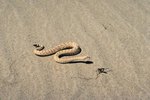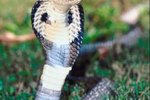
Much of the eastern half of the United States is home to five species of copperhead snakes (Agkistrodon contortrix). Once abundant throughout their range, native populations of these venomous pit vipers have declined drastically. Protected and facing endangerment in Massachusetts, New Jersey and Iowa, copperheads have taken a hard hit as roadkill as well as from loss of habitat and wanton human destruction. The copperhead is a much maligned reptile, and yet not only does it not deserve its bad rap, it also may offer hope to descendants of the very species, humans, who sought to destroy it.
Old Enemies, New Hope
The venom of a copperhead contains a protein called contortrostatin, discovered through the research of University of Southern California chemistry professor Frank Markland. This protein appears to block cell migration in a peculiar way. Markland's team injected human breast cancer cells into the mammary glands of mice, then injected contortrostatin into the glands two weeks later. The protein inhibited the tumor's growth as well as the growth of the blood vessels that supplied the tumor with nutrients. It also interfered with the tumor's spread to the lungs -- a typical site for breast cancer to metastasize. While it's a long way from the lab to the pharmacy, contortrostatin offers new hope in the battle against an old and tenacious enemy, cancer.
They Shall Take Up Serpents
The copperhead plays an eyebrow-raising role in American cultural history. The Bible's prophesy "They shall take up serpents" gave rise to modern Pentecostal snake-handling services. Because Pentecostals take the words of the Bible literally, in 1910, George W. Hensley, a preacher in Tennessee, felt that his congregation should take up copperheads and rattlesnakes during the church's faith rituals. The movement spread through the Bible Belt, gaining media and lawmaker attention in the 1940s, when snake-handling services were outlawed. Hensley and his parishioners ignored the laws and were arrested repeatedly. Bitten by venomous snakes numerous times throughout his life, Hensley died from a bite in 1955. While mainstream Pentecostal organizations condemned the practice long ago, about 2,500 members of small autonomous churches, mostly in Appalachia, continue to participate in snake-handling rituals.
Don't Tread on Me
The copperhead's threat and strike techniques differ from those of North America's other pit vipers, rattlesnakes and water moccasins. While its viper relatives always try to make a fast getaway when they perceive danger, the copperhead typically freezes in its tracks -- remaining motionless while waiting for the menace to pass. Should the danger continue to approach, the copperhead issues a threat -- in the form of a bite rather than the warning displays offered by rattlesnakes and moccasins preceding a strike. Because this threat bite isn't intended to kill but to warn, little if any venom is injected. Wasting precious venom is pointless if the snake can chase the intruder away with a minor bite.
In Plain Sight
The coppery red top of this animal's head fades into pinkish to brown-gray body color crossed with hourglass-shaped patterns of dark chestnut color. Copperheads are nearly impossible to notice when lying on reddish soils or dead leaves. Even if you approach closely, this snake remains motionless unless physical contact occurs -- then it strikes. This freezing behavior is thought to have evolved as a result of the camouflage's effectiveness and is probably why more people are bitten by copperheads than by any other species. Look before you step -- take a walking stick with you when hiking in copperhead country.
References
- Savannah River Ecology Laboratory: Copperhead (Agkistrodon contortrix) -- Venomous
- Animal Diversity Web: Agkistrodon contortrix -- Southern Copperhead
- Journal of the National Cancer Institute: Snake Venom Protein Paralyzes Cancer Cells
- American Museum of Natural History: Using Snake Venom Protein to Fight Cancer
- Christianity Today: Christian History -- They Shall Take Up Serpents
- NPR: Snake-Handling Preachers Open Up About 'Takin' Up Serpents'
- North Carolina State University Cooperative Extension: How Dangerous Are Copperhead Snakes?
- Snake Removal: Copperhead Snake Information and Facts
Resources
Photo Credits
-
Jupiterimages/Photos.com/Getty Images
Writer Bio
A full-time writer since 2007, Axl J. Amistaadt is a DMS 2013 Outstanding Contributor Award recipient. He publishes online articles with major focus on pets, wildlife, gardening and fitness. He also covers parenting, juvenile science experiments, cooking and alternative/home remedies. Amistaadt has written book reviews for Work At Home Truth.




